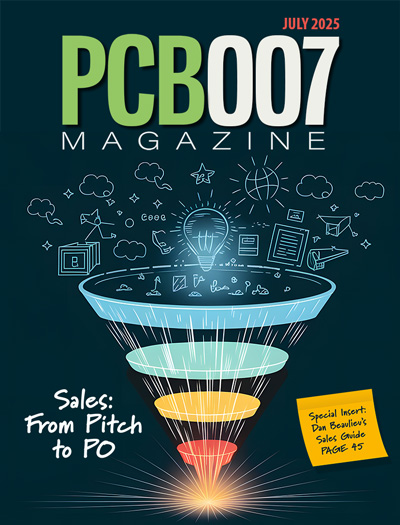-

- News
- Books
Featured Books
- pcb007 Magazine
Latest Issues
Current Issue
Advancing the Advanced Materials Discussion
Moore’s Law is no more, and the advanced material solutions to grapple with this reality are surprising, stunning, and perhaps a bit daunting. Buckle up for a dive into advanced materials and a glimpse into the next chapters of electronics manufacturing.

Inventing the Future With SEL
Two years after launching its state-of-the-art PCB facility, SEL shares lessons in vision, execution, and innovation, plus insights from industry icons and technology leaders shaping the future of PCB fabrication.

Sales: From Pitch to PO
From the first cold call to finally receiving that first purchase order, the July PCB007 Magazine breaks down some critical parts of the sales stack. To up your sales game, read on!
- Articles
- Columns
- Links
- Media kit
||| MENU - pcb007 Magazine
Estimated reading time: 1 minute
Goodbye to Trial and Error?
All the time you spend at the production line for trial-and-error runs, just to get your production board right, takes away from your real production time. It comes on top of the time spent for trial and error at the screenprinter, and any other equipment in the line. All this can take an hour or more for each production board but, with all the tools now available, it can easily be significantly reduced. In addition, though, there are time-consuming actions (like loading all the feeders) to get right before the first error-free board comes out of the machine.
So, how do you minimize the whole trial-and-error process to ensure that, when a program starts up and feeders and toolbits are already on the system, the first board coming out of the machine is immediately good?
A perfect first board would mean that the correct components were all picked from the correct feeder and placed on the correct location at the correct placement angle. Guaranteeing this means ensuring that all the many pre-defined variables are correct: enough paste, exact board positioning, precise artwork, correct components picked by the correct toolbits and placed exactly. The more variables that are incorrect, the longer the ramp-up will take. The more programs each shift that require correcting, the shorter your effective production time and thus fewer boards produced. And during ramp-up, it’s better that the system stops to signal a fault than finding it out at the end during board test. It also helps save ramp-up time if all components are actually picked to get the program started immediately without false starts.
Read the full column here.
Editor's Note: This column originally appeared in the January 2014 issue of SMT Magazine.
More Columns from SMT Trends & Technologies
SMT Trends and Technologies: What is Your Real Output?SMT Trends & Technologies: Goodbye to Trial and Error?
SMT Trends and Technologies: Pick and Paste
SMT Trends and Technologies: Doing More Than One Thing at a Time
SMT Trends & Technologies: Clash of Clans - The New Expansion of PCB Assembly Equipment
What is Your Real Output?


